This Whole Roasted Chicken recipe is made with simple ingredients for the best flavorful and juicy meat.
The chicken gets flavored with a homemade garlic herb butter, fresh herbs and fresh lemon. Roast it by itself or with carrots and potatoes for a delicious Sunday roast!
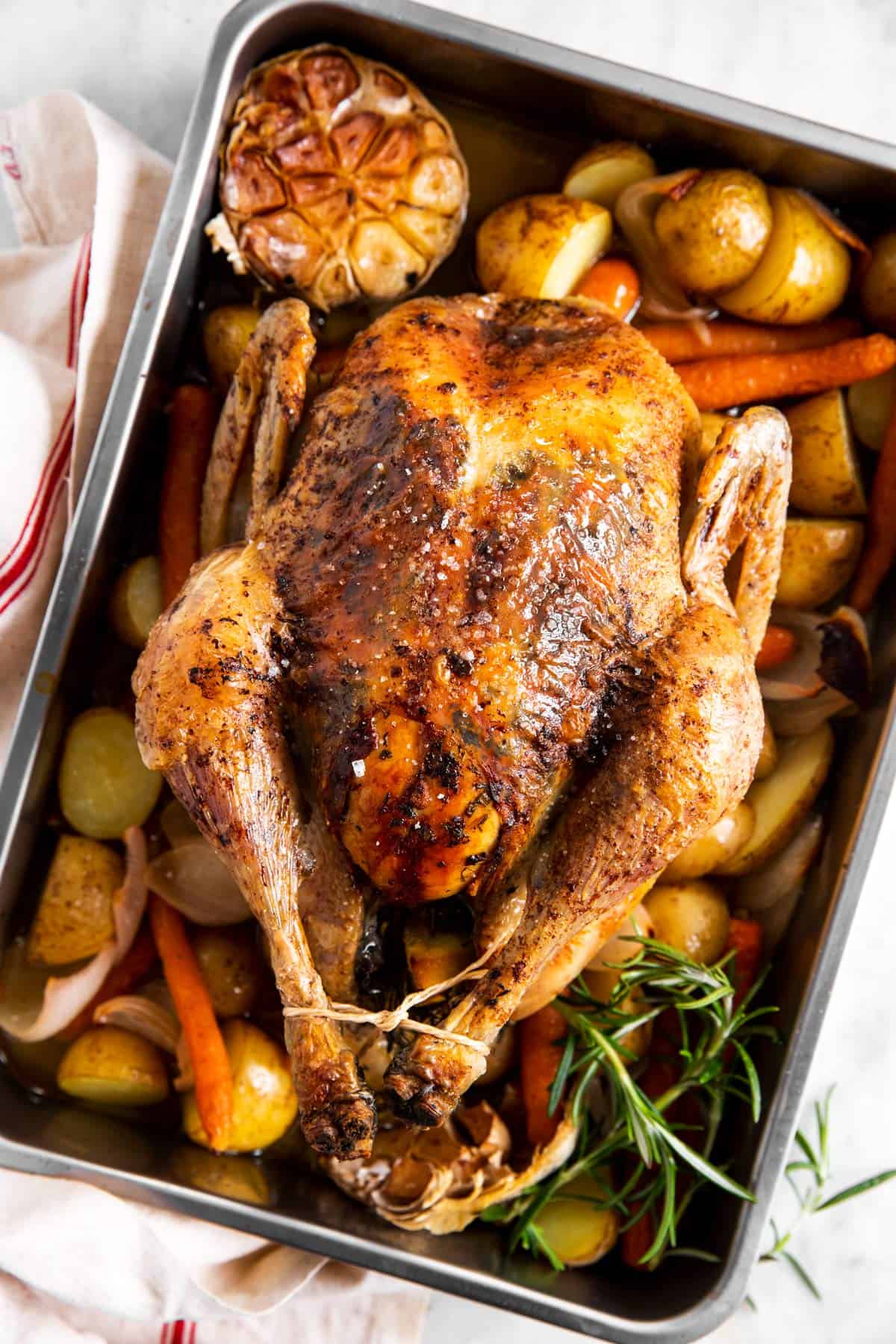
Roast chicken recipe
A whole roasted chicken is one of out favorite dinners – it’s just such a wonderful classic I like to make again and again!
- The chicken comes out so flavorful from the garlic herb butter, plus the fresh lemon and herbs stuffed inside the cavity.
- The juices form a delicious pan sauce. I never even cook it into a proper gravy (although you are free to do so if you’d like!), because the pan juices are so delicious by themselves.
- Roasting for longer at a lower temperature, plus starting and finish for a shorter time at a higher temperature means the meat stays deliciously juicy while the skin gets browned and caramelized – the best of both worlds!
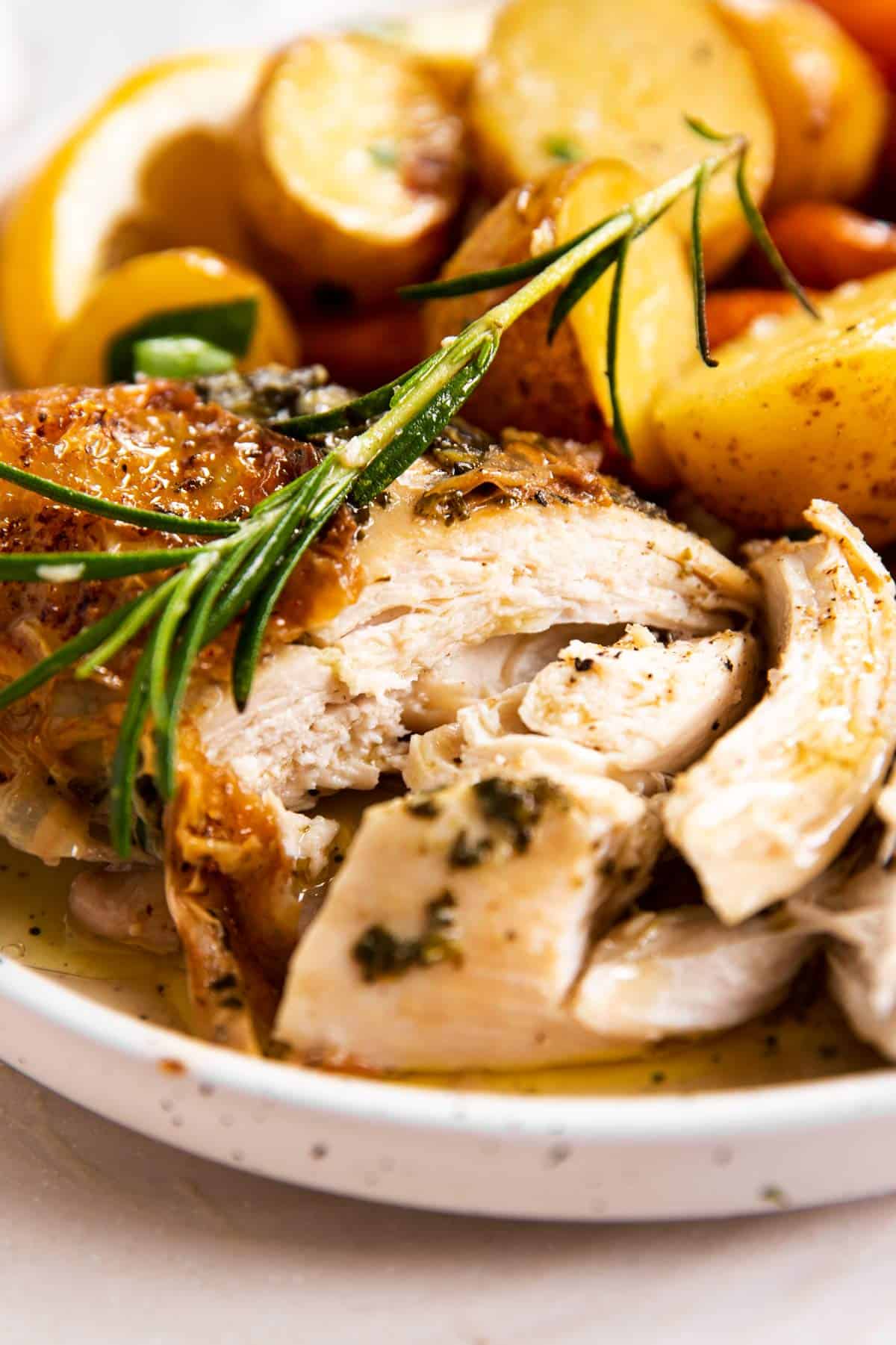
Ingredients you’ll need
Here is a visual overview of the ingredients in the recipe. Scroll down to the printable recipe card at the bottom of this post for quantities!
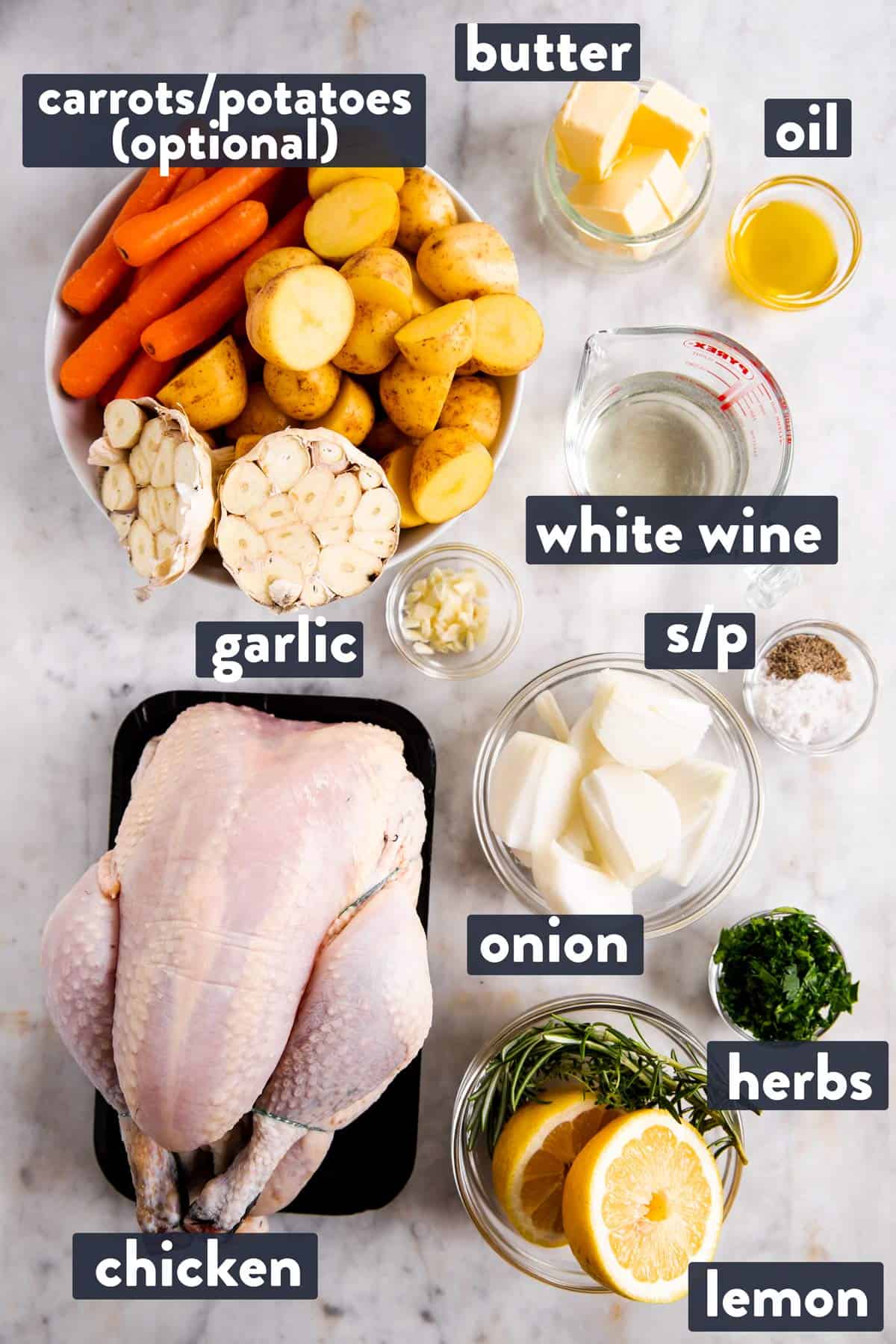
Ingredient notes
- Chicken: I used an around 3.5 pound organic chicken. The shape was a little funny but I decided nature wasn’t meant to be perfect, so I went with it ? you can really use any size chicken, but you’ll need to adjust both the size of your roasting pan and the roasting time.
- White wine: I love adding this to the roasting pan for some extra flavor. The alcohol should cook off entirely, according to science. If you want to avoid using wine, just use chicken broth instead!
- Onion: I prefer using white onions for this recipe, but yellow ones will do in a pinch.
- Lemon: If you’re not a fan of lemon flavor or don’t have any on hand, you can also stuff the chicken cavity with a quartered onion.
- Garlic: I love placing a whole halved head of garlic in the roasting pan, plus minced garlic into the garlic butter I season the chicken with. But if you’re not a huge garlic fan, feel free to skip the head of garlic in the pan.
- Butter: If you need to avoid dairy, I recommend using either a dairy-free butter or a really good margarine that indicates on the package that it’s fine to use in high temperature settings.
- Herbs: Rosemary and thyme are classics to use in the chicken cavity, plus use both of these chopped together with chopped parsley in the garlic herb butter.
- Carrots/potatoes: These are optional, if you want to use the chicken by itself then just skip them. We love adding the vegetables if we’re making a whole chicken for our Sunday dinner! But even if I’m roasting a couple of chickens to use in other recipes, I usually throw some vegetables into the roasting pan, just because they turn out so delicious in the rendered fat!
How to roast a whole chicken
This is a walk-through of the recipe with step photos. Skip to the printable recipe card at the bottom for exact times and temperatures.
1. Start by removing your chicken from the fridge 30 minutes before roasting (remove giblets/neck if your butcher hasn’t done this yet). Get all of your ingredients ready, then pre-heat your oven to 450°F.
2. Make the compound butter (just mash softened butter with minced garlic, chopped fresh herbs, a pinch of salt and pepper), then very carefully loosen the chicken skin.
I recommend to lightly salt the chicken all over (inside and out!), then stuff about ⅔ of the compound butter under the chicken skin and the remaining ⅓ into the chicken cavity.
compound butter how to loosen chicken skin seasoned chicken in pan with onion, garlic and white wine
3. Place the onion and garlic in the roasting pan and sit the chicken on top. Halve or quarter the lemon (depending on your chicken size) and stuff it into the cavity together with a few sprigs of fresh rosemary and thyme. Brush the chicken skin with oil all over. Then pour the white wine into the dish and roast the chicken for 15 minutes at 450°F.
4. Carefully remove the dish from the oven to baste the chicken with the juices from the pan for the first time.
If you want to add carrots and potatoes, do so now (lift out the chicken onto a large plate, add the vegetables/toss them with the juices in the pan, then sit the chicken on top).
baste chicken during roasting add vegetables if you like
Reduce the oven temperature to 350°F and roast the chicken for 20-25 minutes per pound, basting the chicken once or twice with the pan juices during the roasting time.
5. Remove the pan from the oven and brush the chicken with butter (no need to melt the butter first, it will melt right on the hot chicken). Increase the oven temperature to 420°F.
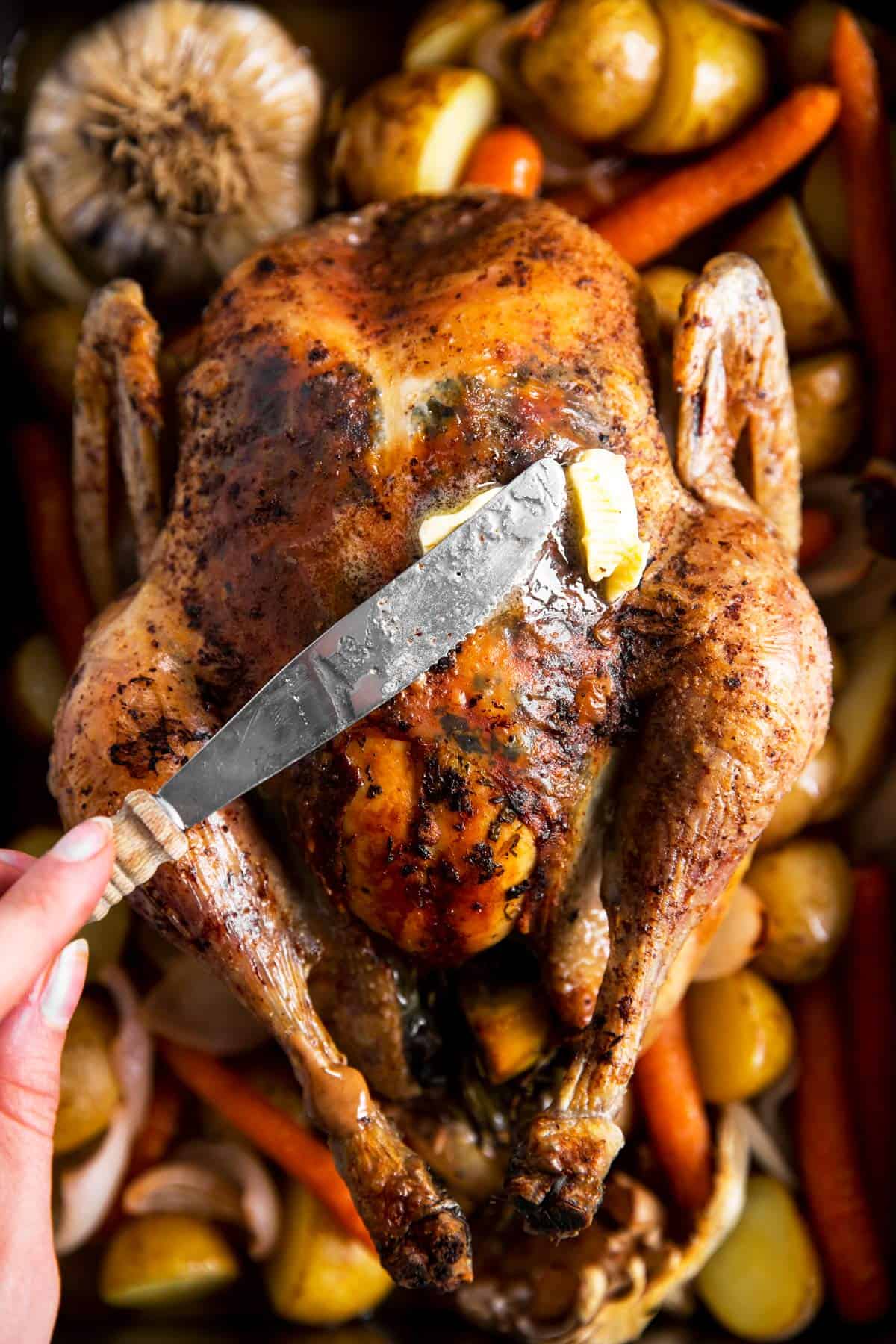
Return the chicken to the oven and roast for another 5-15 minutes, until the internal temperature in the thickest part of the breast, and where the leg connects to the body (not at the bone but in the meat!) registers 165°F on a meat thermometer (Source: FoodSafety.Gov).
6. Remove the pan from the oven and remove the chicken to a warmed plate or a rimmed wooden chopping board.

Drain the pan juices into a gravy boat and keep warm. Allow the chicken to rest for 15-20 minutes before carving to serve.
If you added carrots/potatoes:
While the chicken rests, return the vegetables to the oven at 425°F and roast for 10-20 more minutes, until fully tender and browned.

(If they are already fully tender once the chicken is done, just keep them warm until the chicken has rested – their roasting time will greatly depend on the exact kind you used; my baby carrots and baby potatoes needed a full 20 additional minutes in the oven).

Recipe tips
- Make sure to remove the chicken from the fridge 30 minutes before putting it into the oven. This helps to cook it more evenly.
- You need about 1 teaspoon of salt per pound of chicken meat to season your bird. Remember, your whole chicken has a lot of weight from the bones, which is not counted in this calculation. For my 3 ½ pound chicken, I used 1 ½ teaspoons of salt, and then finished it with some coarse sea salt in the end. Make sure to use a pinch bowl with a few teaspoons of salt added when seasoning your chicken inside and out. Discard any remaining salt. Never keep salt you touched with hands that also touched raw chicken at the same time!
- I highly recommend tying the legs together to help keep the breast meat from drying out. Make sure to use food-grade, oven-safe twine. I grabbed the wrong one because I was in a hurry, and while it was food safe, it was waxed and the wax completely melted. The chicken was still perfectly fine to eat (the wax was only on the leg bones), but it still annoyed me. Let my mistake be your cautionary tale!
- The chicken skin will soften up during the resting time. I just wanted to mention this in case you’re hoping for crispy skin. If you wanted the skin to stay crispy, you’d have to remove it from the chicken ASAP when you remove it from the oven and either eat it right away or keep it on a cooling rack. I don’t recommend doing this, because it will cause the meat underneath to start drying out. Also, then skin holds juices and melted butter that keep the meat juicy, too.
- I don’t recommend covering the chicken during resting, because it will make it soggy. The meat is still perfectly hot (I find it almost too hot to carve, even after 20 minutes of resting), as long as it is at room temperature and you don’t have all of your windows open to create a cool draft around your chicken.
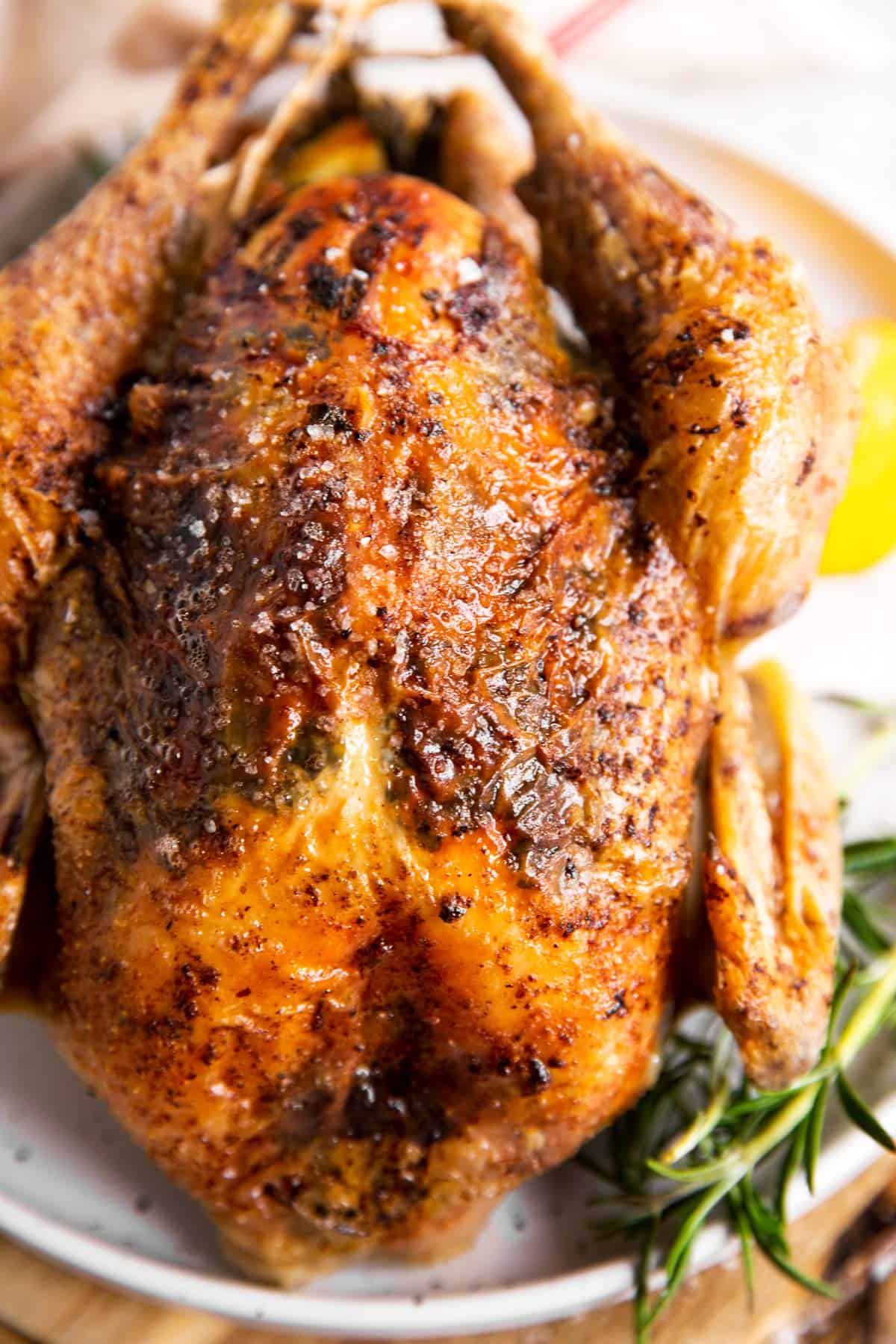
How to carve a chicken
Carving a whole chicken can feel very intimidating if you’ve never done it before, but it’s quite simple to do once you know what you have to do.
This job is easier to complete with chicken shears or a good carving knife, but if you don’t have either, use your sharpest kitchen knife.
Start by cutting away the legs. Disconnecting the leg joint from the body is definitely something I find is easier with chicken shears vs a carving knife. If the leg doesn’t seem to come away after you sliced all around it (it will only be connected at the joint/with the bone at this point), use your hands to carefully rotate it to disconnect it at the joint.
Next, slice away the wings – again, rotate to disconnect at the joint if you can’t slice them off.
remove the legs remove the wings slice away the breast meat pick off any remaining meat
Next, slice away each chicken breast, and finally pick off any remaining meat from the carcass.

Roasted chicken FAQs
I prefer to roast the chicken uncovered to help it achieve a nice color and caramelization. If your chicken skin starts to get too dark before the internal temperature reaches 165°F, tent the chicken with aluminium foil to keep it from scorching and burning.
I like to add a liquid to the pan to keep the drippings from burning and to yield a nice, flavorful pan sauce to serve over the carved chicken. I prefer to use a more flavorful liquid like white wine or chicken broth instead of water.
Your chicken will cook more evenly and retain more juices/stay juicier if you allow it to sit at room temperature for 30 minutes before roasting it. I highly recommend to do this, it really does yield a better roasted chicken!
You roast the chicken breast side up.
Serving ideas
We pretty much always have the chicken with the roasted potatoes and carrots in the pan.
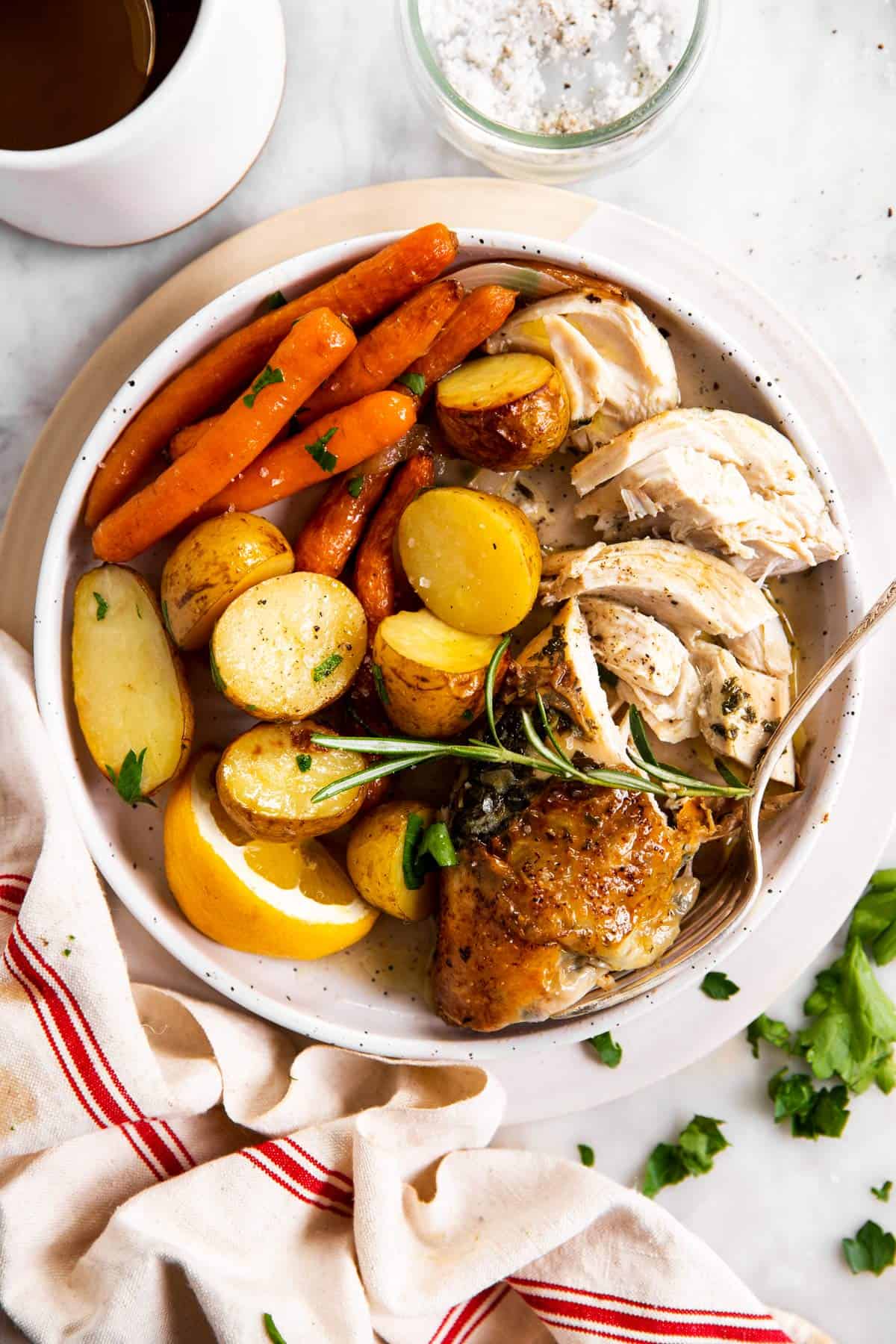
But if that’s not your thing, there are plenty of other ideas to serve with a whole roasted chicken!
- Sautéed green beans (or Air Fried Green Beans)
- Roasted Asparagus (or Air Fryer Asparagus)
- Mashed Potatoes (or Instant Pot Mashed Potatoes)
- Roasted Broccoli
- Creamy Cucumber Salad
- Tomato Cucumber Salad
- Cherry Tomato Salad
- Creamed Corn or Creamed Spinach

How to use leftovers
Store leftovers in an airtight container in the fridge for up to 4 days.
- Use the shredded breast meat in chicken salad for an extra-flavorful sandwich filling
- Use shredded chicken to make a chicken taco salad
- Use leftover roasted chicken in a chicken tamale pie
- Make some buffalo chicken dip
PS If you try this recipe, please leave a review in the comment section and add a star rating in the recipe card – I appreciate your feedback! Follow along on Pinterest, Facebook or Instagram.
Printable recipe
Whole Roasted Chicken
Recipe details
Ingredients
For the compound butter
- 4 tablespoons unsalted butter softened
- 3 cloves garlic finely minced
- 2 tablespoons freshly chopped herbs I used parsley, thyme and rosemary
- salt and ground black pepper to taste
For the chicken
- 1 whole chicken mine was 3.5 pounds; any weight will work; make sure to adjust roasting time and use a roasting pan to fit your chicken’s size! Adjust quantity of compound butter, but leave other ingredients the same.
- 1 lemon halved or quartered (depending on chicken size)
- 3 sprigs fresh thyme
- 3 sprigs fresh rosemary
For the pan/to finish
- 2 white onions trimmed, peeled and quartered
- 1 head garlic halved crosswise
- ½ cup white wine OR chicken broth
- olive oil for brushing
- butter for brushing
Optional vegetables
- 1 pound carrots peeled and cut into chunks (I used whole baby carrots)
- 1 ½ pounds potatoes cut into 1-inch pieces (I used halved baby potatoes)
Instructions
- Prep chicken: Remove chicken from fridge 30 minutes before roasting. Remove giblets/neck, if applicable. Remove any excess fat and leftover feathers. Pat dry.
- Oven: Pre-heat oven to 450°F (225°C).
- Compound butter: Make compound butter by mashing softened butter, minced garlic, chopped herbs, a pinch of salt and pepper to taste.
- Season chicken: Gently loosen chicken skin. Season chicken with salt/pepper all over (inside and out). Spread ⅔ of compound butter under skin. Spread remaining compound butter inside chicken cavity.
- Prep pan and finish prepping chicken: Place onions and head of garlic in a lightly oiled roasting pan. Sit chicken, breast side up, on top. Stuff chicken cavity with halved (or quartered) lemon and fresh rosemary/thyme sprigs. Tie legs with kitchen twine and tuck wings under. Brush chicken skin all over with olive oil.
- First part of roasting: Roast chicken at 450°F for 15 minutes. Carefully remove pan from oven and baste chicken with pan juices. (If using potatoes and carrots, carefully lift chicken out of pan onto a plate, add vegetables to pan and toss with juices. Sit chicken back on top.)
- Main part of roasting: Reduce oven temperature to 350°F. Return chicken to oven and roast for 20-25 minutes per pound. Baste once or twice with pan juices during roasting time.
- Finish roasting: Once roasting time is up, remove pan from oven and spread chicken with butter all over. Increase oven temperature to 425°F and roast chicken for 5-15 minutes, until thickest part of meat at thigh and in breast registers an internal temperature of 165°F (if your chicken is already at temperature once roasting time is up, do not continue roasting at 425°F – instead, broil for 2-3 minutes).
- Rest chicken: Remove pan from oven and remove chicken to a warmed rimmed plate OR a wooden chopping board with rim. Rest for 15-20 minutes before serving. Drain pan juices to a gravy boat and keep warm. (If you added the potatoes and carrots and they aren't fully tender yet, return to the oven and roast at 425°F for 10-20 more minutes, until chicken is rested/carved and vegetables are fully tender).
- Serve: Carve rested chicken and serve with pan juices (and optionally potatoes and carrots).
Notes
Ingredient notes
- Chicken: I used an around 3.5 pound organic chicken. The shape was a little funny but I decided nature wasn’t meant to be perfect, so I went with it ? you can really use any size chicken, but you’ll need to adjust both the size of your roasting pan and the roasting time.
- White wine: I love adding this to the roasting pan for some extra flavor. The alcohol should cook off entirely, according to science. If you want to avoid using wine, just use chicken broth instead!
- Onion: I prefer using white onions for this recipe, but yellow ones will do in a pinch.
- Lemon: If you’re not a fan of lemon flavor or don’t have any on hand, you can also stuff the chicken cavity with a quartered onion.
- Garlic: I love placing a whole halved head of garlic in the roasting pan, plus minced garlic into the garlic butter I season the chicken with. But if you’re not a huge garlic fan, feel free to skip the head of garlic in the pan.
- Butter: If you need to avoid dairy, I recommend using either a dairy-free butter or a really good margarine that indicates on the package that it’s fine to use in high temperature settings.
- Herbs: Rosemary and thyme are classics to use in the chicken cavity, plus use both of these chopped together with chopped parsley in the garlic herb butter.
- Carrots/potatoes: These are optional, if you want to use the chicken by itself then just skip them. We love adding the vegetables if we’re making a whole chicken for our Sunday dinner! But even if I’m roasting a couple of chickens to use in other recipes, I usually throw some vegetables into the roasting pan, just because they turn out so delicious in the rendered fat!
Recipe tips
- Make sure to remove the chicken from the fridge 30 minutes before putting it into the oven. This helps to cook it more evenly.
- You need about 1 teaspoon of salt per pound of chicken meat to season your bird. Remember, your whole chicken has a lot of weight from the bones, which is not counted in this calculation. For my 3 ½ pound chicken, I used 1 ½ teaspoons of salt, and then finished it with some coarse sea salt in the end. Make sure to use a pinch bowl with a few teaspoons of salt added when seasoning your chicken inside and out. Discard any remaining salt. Never keep salt you touched with hands that also touched raw chicken at the same time!
- I highly recommend tying the legs together to help keep the breast meat from drying out. Make sure to use food-grade, oven-safe twine. I grabbed the wrong one because I was in a hurry, and while it was food safe, it was waxed and the wax completely melted. The chicken was still perfectly fine to eat (the wax was only on the leg bones), but it still annoyed me. Let my mistake be your cautionary tale!
- The chicken skin will soften up during the resting time. I just wanted to mention this in case you’re hoping for crispy skin. If you wanted the skin to stay crispy, you’d have to remove it from the chicken ASAP when you remove it from the oven and either eat it right away or keep it on a cooling rack. I don’t recommend doing this, because it will cause the meat underneath to start drying out. Also, then skin holds juices and melted butter that keep the meat juicy, too.
- I don’t recommend covering the chicken during resting, because it will make it soggy. The meat is still perfectly hot (I find it almost too hot to carve, even after 20 minutes of resting), as long as it is at room temperature and you don’t have all of your windows open to create a cool draft around your chicken.
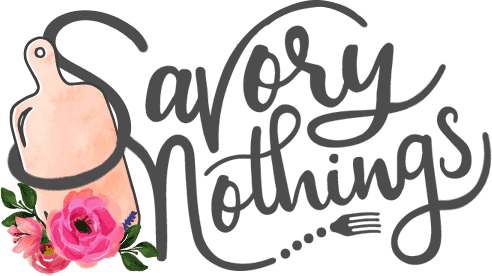


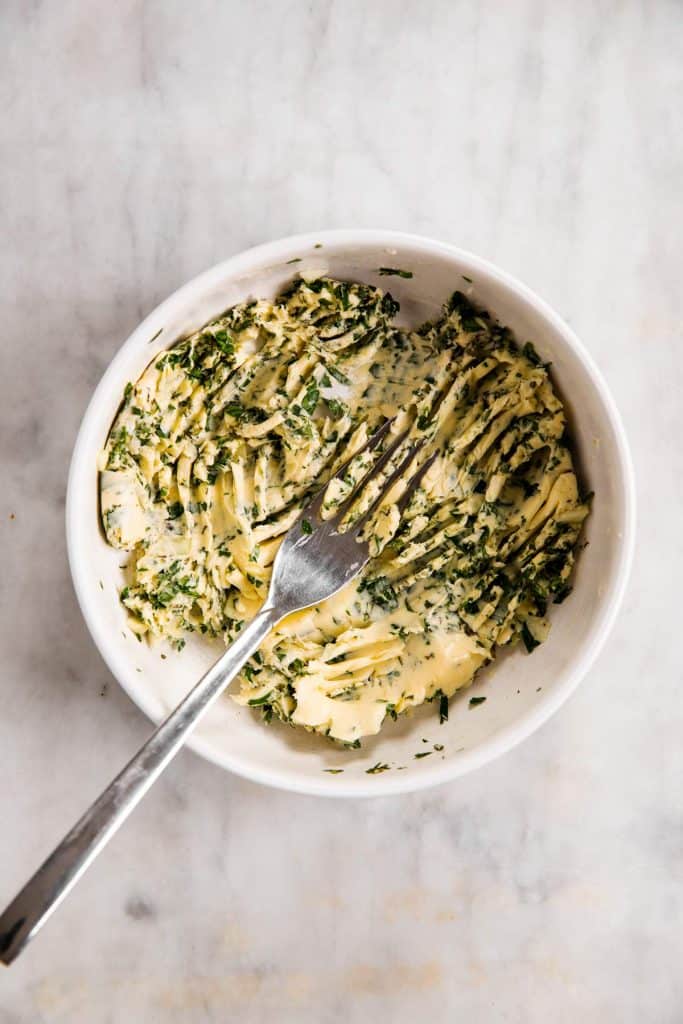




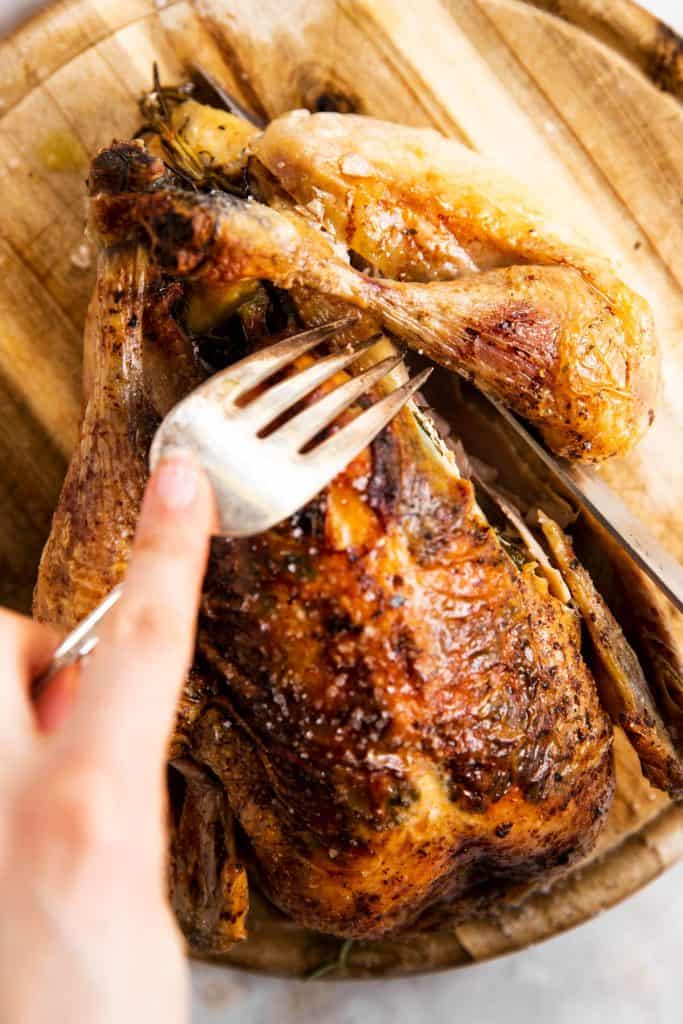
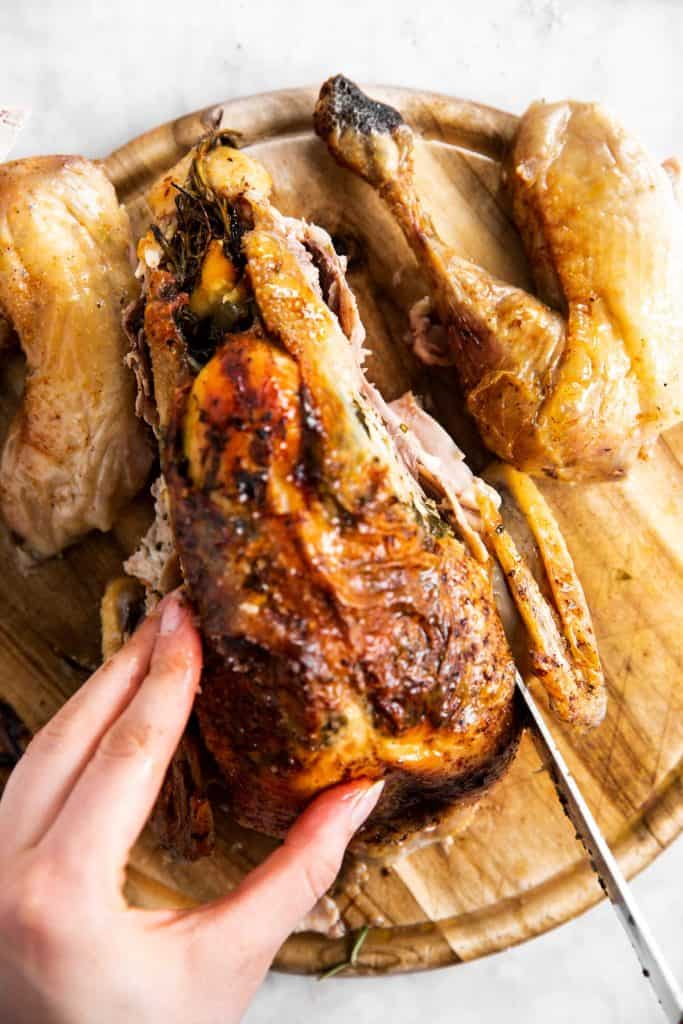



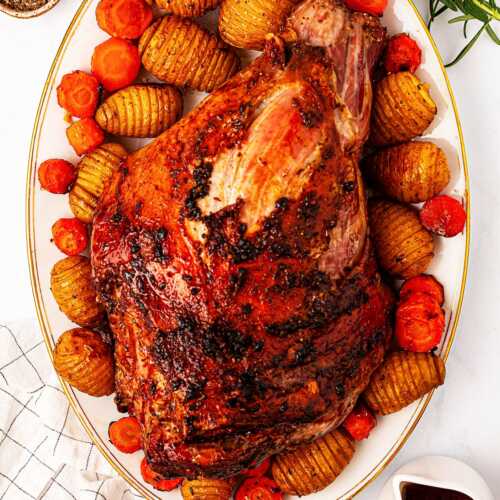



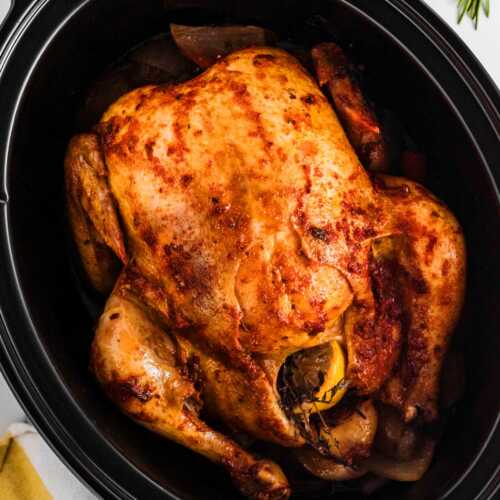
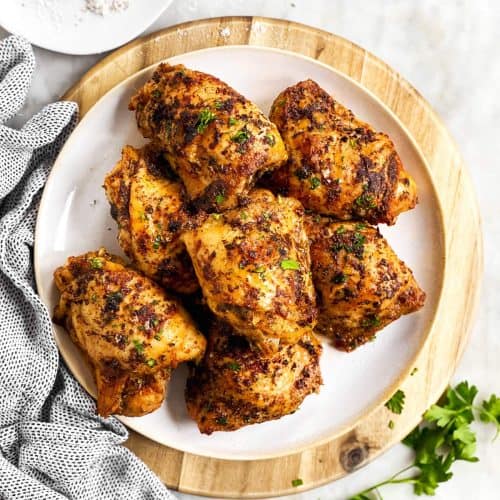




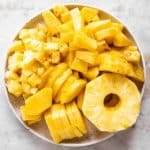
Tillie says
Excellent recipe! Flavorful & moist. It’s a bit involved but definitely worth it. The only modification was I added mushrooms. This will be my ‘go to’ roasted chicken recipe from now on!
Nora says
I’m so glad, Tillie!